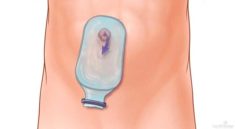Rectal Cancer Surgery is the main treatment for rectal cancer. Radiation therapy or chemotherapy is often given before or after surgery.
The type of surgery will arise from the stage (extent) of the cancer, where it is located, a key piece of information needed before surgery is how close to the anus the tumor is, which influences the type of surgery to be performed.
This may also have an effect on the outcome if the cancer has spread to the sphincter muscles in the form of rings around the anus that prevent the passage of stool until the muscles relax for a bowel movement.
Polypectomy and local excision A
Some cases of early rectal cancer and most polyps can be removed during a colonoscopy. The following surgical procedures may be performed during a colonoscopy:
In a polypectomy, the cancer is removed as part of the polyp, which is cut out at its stem (the area that looks like a mushroom stem).
A local excision involves a slightly more complex procedure. Instruments are used through a colonoscopy to remove small cancers within the lining of the rectum along with a small amount of healthy tissue on the wall of the rectum.
When cancer or polyps are removed in this way, the surgeon does not need to make a cut over the abdomen.
Local transanal resection (full-thickness resection of the rectal wall)
This procedure can be used to remove some early stage I cancers, which are relatively small and not far from the anus. This procedure is usually done under local anesthesia (medication that reduces sensation), but the patient is not asleep during the operation.
In this operation, the surgeon makes a cut through all the layers of the rectum to remove the cancerous tumor as well as some of the normal tissue. The hole in the rectal wall is then closed.
Lymph nodes during this procedure are not removed, so if the tumor has grown deep into the rectum, radiation with or without chemotherapy may be recommended after surgery.
Low anterior resection
Some stage I rectal cancers and most stage II or III cancers in the upper part of the rectum (near where it connects to the colon) can be removed with a low anterior resection. In this operation, the part of the rectum that contains the tumor is removed. The colon is then attached to the remaining part of the rectum (immediately after removal of the tumor or later in another surgery) so that the patient can have a bowel movement in the usual way.
A low anterior resection is done under general anesthesia to put the patient into a deep sleep without feeling pain. The surgeon proceeds to make small incisions (cuts) on the abdomen. The cancer and a margin (border) of normal tissue around the tumor are removed, along with lymph nodes and other tissue around the rectum.
The colon is then reconnected to the remaining rectum, so a permanent colostomy is not necessary (a colostomy is necessary when, instead of reconnecting the colon and rectum, the upper end of the colon is connected to an opening made on the skin of the abdomen and through which fecal residues are discarded).
If radiation therapy and chemotherapy are given before surgery, it is common to have a short-term ileostomy (this involves connecting the end of the small intestine, the ileum, to a hole made on the skin of the abdomen). This gives the rectum time to heal before fecal waste is evacuated back through the colon. In most cases, the ileostomy can be reversed (the intestines are reconnected) after about eight weeks.
Most patients will spend 4 to 8 days in the hospital after a low anterior resection, depending on how the surgery was performed and their general health. Recovery may take three to six weeks at home.
Abdominoperineal resection
This operation is more complex than the low anterior resection. It may be used to treat some stage I and many stage II and III cancers that are found in the lower part of the rectum (the part near the anus).
It is often needed when the cancer has grown into the sphincter muscle (which keeps the anus closed to prevent stool from coming out) or when the tumor is near the muscles that help control the flow of urine ( referred to as levator muscles).
In this procedure, the surgeon makes a cut or incision (or several small incisions) on the skin of the abdomen and another on the skin around the anus.
This allows the surgeon to remove the rectum, anus, and surrounding tissues, including the sphincter muscle. Due to the removal of the anus, a permanent colostomy (the end of the colon is connected to a hole made on the skin of the abdomen) will be left to allow the expulsion of fecal waste from the body.
This operation requires the use of general anesthesia (use of medication to put the patient in a deep sleep during the procedure). Most patients will spend several days in the hospital after surgery, depending on how the operation was performed and their general health. The recovery period at home can be three to six weeks.
Risks of rectal surgery
The possible risks and side effects of surgery depend on several factors, including the extent of the operation and the person’s general health before surgery. Problems that may occur during or shortly after the operation may include: bleeding from the surgery, infections at the site of the surgery, and blood clots in the legs.
The new connections between the ends of the colon may not stick together, causing a leak. This can quickly lead to severe abdominal pain, fever, and a feeling of hardness in the stomach region. A minor leak may prevent bowel movements, loss of appetite, and recovery from surgery may not be possible.
A leak can lead to infections and surgery may be required to fix this problem. It is also possible that the incision in the abdomen opens an open wound that requires special attention to heal.
After surgery, you may have scar tissue in your abdomen that causes some organs or tissues to stick together. These scar tissues are called adhesions. Normally the intestines can slide freely inside the body. In rare cases, adhesions can cause the intestines to twist and may even block the intestines. This causes pain and swelling in the stomach that is often worse after eating. Another operation may be required to remove the scar tissue.
After the surgery
Upon awakening after surgery, there will be some pain and pain medication will likely be needed for several days. For the first few days, eating may not be possible or limited fluid intake may be allowed as the colon needs time to recover.
Most people can go back to solid food after a few days.
Postoperative follow-up
You should follow up with your treating surgeon because even if all visible cancer is removed, there may be cancer cells in other parts of the body.
When these cancer deposits are very small, they cannot be detected at the time of surgery and can start to grow later.
Patients with recurrent cancers, if diagnosed early, may deteriorate or be cured with further surgery or other treatment.
Another good reason for postoperative follow-up is to look for new polyps in the colon or rectum. about one in five colon cancer patients will have new polyps later.
It is important to find and remove these polyps before they become cancerous.
How long will my follow-up program last?
Most recurrent cancers are found within the first two years after surgery. Therefore, monitoring is more frequent during this period.
After five years, almost all cancers that will come back will have done so.
Follow-up after five years is mainly done to detect new polyps and, therefore, may be less frequent, although it is recommended to do it for life.
What can I expect at my follow-up visit?
Your doctor will see you about every two to three months for the first two years, and will discuss your progress with you. Carcinoembryonic tumor testing (CEA), which is a method of detecting cancer recurrence, may be performed.
Because this test is not completely safe, other follow-up tests may be recommended. These tests may include a flexible sigmoidoscopy (examination of the rectum and lower colon with a flexible, lighted instrument), a colonoscopy (examination of the entire colon with a long, flexible instrument), chest x-ray, and sometimes CT scans. (CT) or ultrasound.
Note:
This information is intended to provide an overview of a surgery. It is not intended to be a substitute for professional medical care or a discussion between you and your surgeon about the need for surgery. Specific recommendations may vary among healthcare professionals. If you have any questions about your need for surgery, your alternatives, or the training and experience of your surgeons, don’t hesitate to do your own research. If you have questions about your surgery or post-op, always discuss them with your surgeon before or after your surgery.



